In reading some of the panic-stricken media commentary about the impending blackouts we were supposed to have this summer, you might have been led to believe that renewable energy doesn’t contribute much at all to ensuring the lights stayed on. If it ain’t baseload then it isn’t any good. The implication is that we therefore we can’t really reduce Australia’s carbon emissions unless we’re prepared to accept regular blackouts or nuclear power.
Unfortunately, it seems our political debate about how we ensure reliable supplies of electricity has been boiled down to some simplistic yes-no question about whether it is “baseload”.
We may even have a policy imposed upon our energy market that will separate powers sources into one of two categories – dispatchable or not dispatchable. If you’re dispatchable then you contribute to a “reliability guarantee”, otherwise you’re out.
But typically the world is a bit more complicated than something that can be boiled down to a simple yes-no question.
While this may come as a surprise to some politicians and media commentators, electricity demand is not constant across all times of the day. Most of the time we’ve got more than enough electricity generating capacity to go around, particularly at night time. The times when demand can get so high as to stretch our available supplies tend to be when businesses are operating and we’re up and about and it’s particularly hot. That co-incidentally happens to be when the sun is out and at intense levels.
Also, it is true that the amount of wind does vary quite a lot – does this mean this source of energy is next to useless?
Green Energy Markets in our recent February edition of the Renewable Energy Index thought it worthwhile to review how much power we received from renewable energy over summer to see whether it was as useless as some political and media commentators might suggest.
No surprises that black coal was by far the most dominant source of electricity over summer, just as it is across the rest of the year.
However, the second largest source of electricity across the main grids of the NEM and South-West Interconnected System was zero emission renewables with 9,880GWh. It was 8% greater than brown coal and 40% more than gas. In case you were wondering, power from oil-based fuels such as diesel were negligible, contrary to suggestions from our energy minister Josh Frydenberg that we had to resort to some huge amounts of pollutant spewing diesel generators to keep the lights on.
Total generation from renewable energy, brown coal, gas and oil over Dec 2017-Feb-2018 across the NEM and SWIS
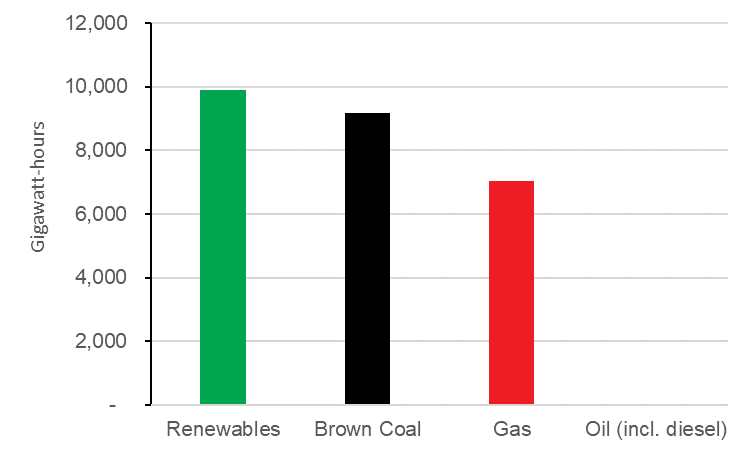
Sources: NEM Review v6, AEMO, and Green Energy Markets estimates of non-AEMO metered renewable energy generators.
But this actually undersells the importance of renewable energy to reliability because it delivered most of its electricity during the periods when demand for power was highest. Over last summer in the NEM, electricity demand was at its highest over the period of 10:30AM to 6:30PM. After 6:30PM power demand was almost always lower than the half hour of 10:30AM-11AM, and it certainly was lower on the days when we had the highest electricity demand.
The chart below details the average amount of power received during each of the hours in the 10:30AM-6:30PM period across the months of December, January and February by fuel type. Please note that the way I’ve labelled the charts is such that 11AM in the chart below and in subsequent charts denotes an average of the power supplied between 10:30AM and 11:30AM and likewise 6PM denotes the average of power across 5:30PM to 6:30PM.
Average generation in NEM from renewable energy compared to brown coal and gas by time of day and month
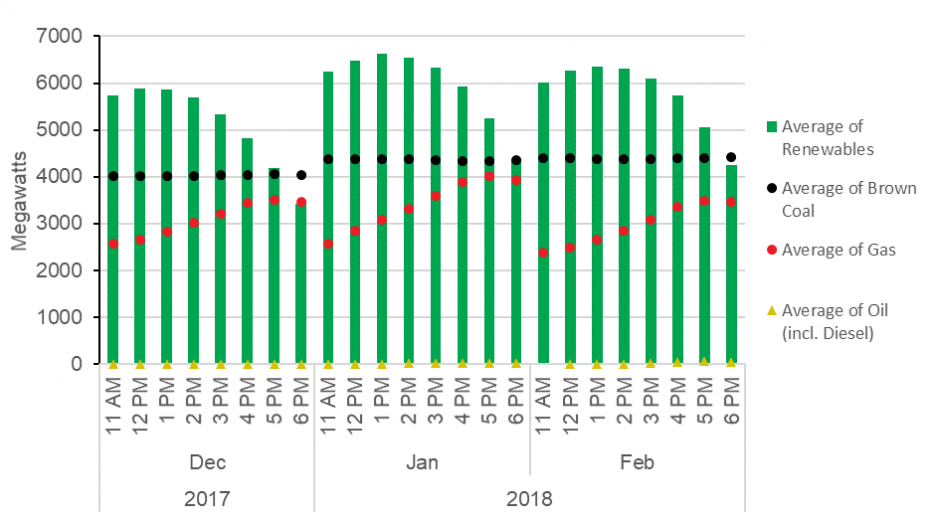
Source: NEM Review v6
The sceptics amongst you might justifiably say, “sure that might be the averages but they can smooth over the sins within the sample of renewable energy’s intermittency”. So let’s instead look at the specific 40 individual half hour periods over summer that represent the highest system-wide demand, instead. These actually show renewable energy producing more power than what we see in the averages, which is partly a function of the fact that system demand reaches its highest point when the sun is beating down.
NEM output from renewables, brown coal and gas in the top 40 highest half hour demand periods over summer
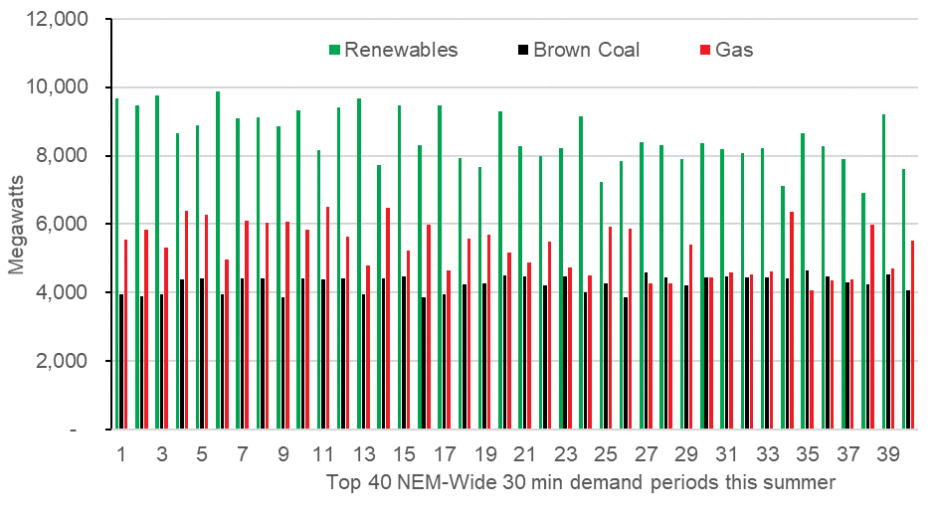
Source: NEM Review v6
It is important to acknowledge that hydro (a dispatchable technology) does play an important part in these figures. To understand its role relative to wind and solar (unfortunately AEMO doesn’t meter most of the bioenergy plants) let’s delve down into the three highest demand days over summer, looking at the half hour periods of time when demand exceeded 32,000MW.
The chart below represents the period when NEM system demand reached its highest point over summer which was 19 December. Demand went over 32,000MW in the period ending 11:30AM and subsided below that level after 5PM. Wind output was quite solid at that time, with wind farms producing about 55% to 60% of their rated capacity across the entire period. Solar PV produced above 3000MW until 2:30, and as it dropped around 3PM hydro generation lifted.
Renewable generation by fuel compared to gas and brown coal by 30 minute interval on the highest NEM demand period last summer (19 Dec)
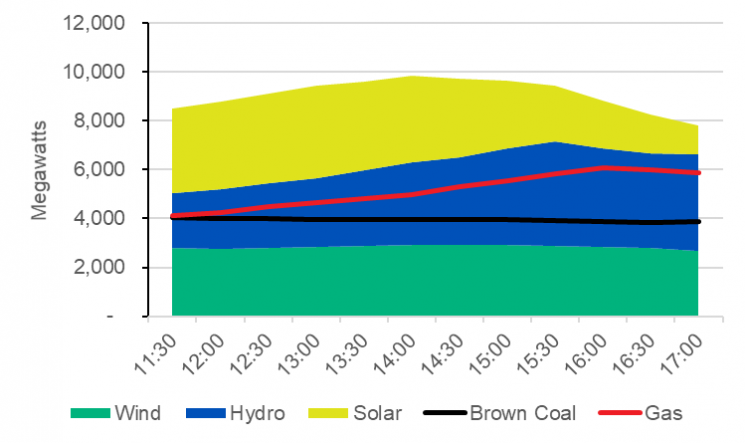
Source: NEM Review v6
The next highest demand day was on 19 January when demand was above 32,000MW from 11AM until 5:30PM. Wind output wasn’t nearly as high on that day at between 802MW to 1,344MW or 16% to 28% of the installed capacity. Is that useless? Well it was about 97% of the output produced by Liddell Power Station over the same time period. Solar meanwhile had a very good day – punching out an average of just over 4,000MW to 2:30PM. Again, as it dropped away in the afternoon, hydro output came up, and produced an average of 4,756MW from 2:30PM to 5PM.
Renewable generation by fuel compared to gas and brown coal by 30 minute interval on the second highest NEM demand period last summer (19 Jan).
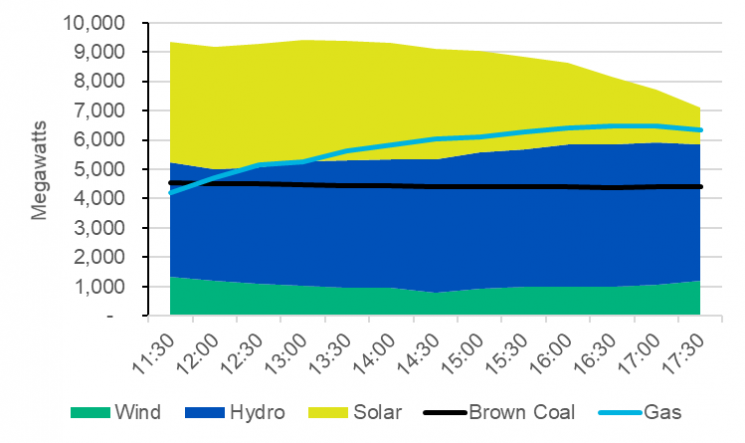
Source: NEM Review v6
On the third highest demand day –22 January – wind output began at 1,057MW as demand clocked over 32,000MW in the 30 minute period preceding 1PM (13:00). It then steadily rose to 1,446MW before demand subsided below 32,000MW after 5PM. Solar output was substantial but not as high as 19 January – providing 3,642MW in the period ending 1PM and remaining above 3000MW until 3PM. Hydro again lifted in the afternoon, and provided an average of almost 3,300MW across the period that demand was above 32,000MW.
Renewable generation by fuel compared to gas and brown coal by 30 minute interval on the third highest NEM demand period last summer (22 Jan).
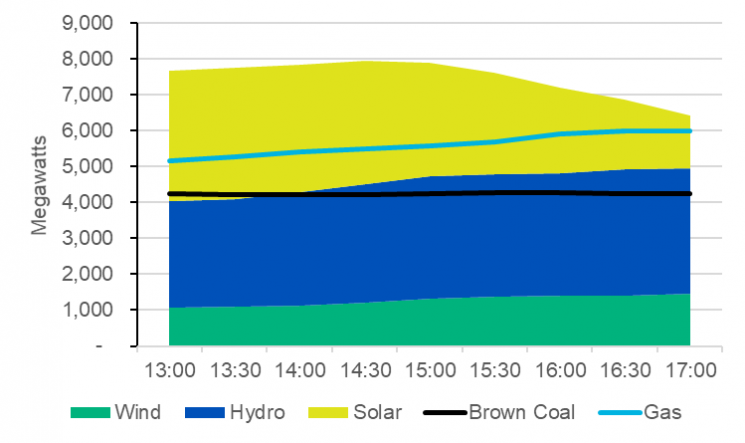
Source: NEM Review v6
So what are the implications of this analysis?
Clearly, renewables are making an important contribution to meeting peak demand and therefore addressing reliability. Yes, it is indisputable that the ability to control the dispatch of hydro plant independent of short-term weather events is vitally important – particularly to meeting demand peaks in the late afternoon and early evening. But solar output’s high correlation with weather events that drive peaks in demand makes it also very valuable.
Wind output isn’t nearly as well aligned with peaks in demand, but it is hardly useless. The chart below details the proportion of wind installed capacity that was generating during the top 50 half hour demand intervals over last summer. For 45 of these 50 intervals wind produced 18% or more of its rated capacity, for half of the intervals it was greater than 41%. Suggestions wind power doesn’t make any useful contribution to meeting peak demand seem to ignore this.
Proportion of NEM wind power’s installed capacity generating electricity during the top 50 half hour demand intervals over last summer.
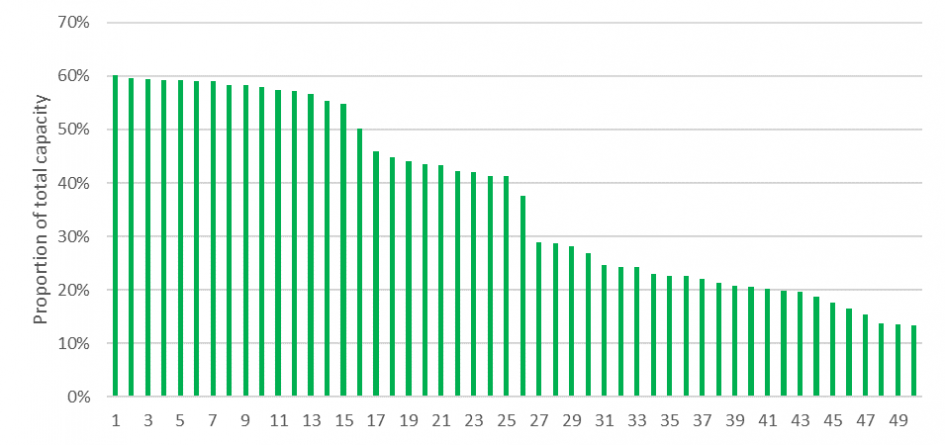
Source: NEM Review v6
In considering the design of the National Energy Guarantee it’s important to note that there is more to ensuring reliability than a simplistic evaluation of whether or not a power generator has dispatchable capacity. The current energy-only market design for the NEM provides a vastly more sophisticated set of incentives for delivering capacity when its required than a central planner can manage. Critically, the incentives are dynamic, responding every five minutes to changes in the supply-demand balance.
There are an incredible array of options available to us to reduce electricity emissions while also ensuring reliable electricity supplies. This will require a sophisticated mixing and matching of different technologies and balancing of statistical probabilities. Controllable dispatchable capacity will clearly be important in balancing out the variability of wind and solar. But at the same time, the geographical spacing of wind and solar will also help, as will greater transmission interconnection. We may also see consumers shift their demand into the midday period to take advantage of high solar output at this time. Further gains in low wind speed turbine technology may also result in less variability in wind farms’ output.
Such a complex array of decisions are best left to market participants, not Barnaby Joyce or Craig Kelly, not Malcolm Turnbull or Bill Shorten, and not even AEMO head Audrey Zibelman.
About our Guest Author
| Tristan Edis is Director – Analysis & Advisory with Green Energy Markets. We assists clients make informed investment, trading and policy decisions in the areas of clean energy and carbon abatement.
You can follow Tristan on Twitter @TristanEdis. |


In terms of savings of greenhouse gasses emissions it is correct to discuss the total quantity of energy generated by the different methods. It is also enlightening to look at the coincidence of generation with load. But discussion like this always chooses to ignores what happens when there is a long period when the renewable energy production falls short of demand. The larger the amount of energy produced from renewable sources the less often alternative generation will be called into service, but what seems to always get ignored is to note it will be called on every so often and it is essential to retain this backup capacity or even to deploy new backup capacity when the old generators become US. What needs much more discussion are the economics of this infrequently called upon backup standby generation plant. Plant with a very low duty cycle is always expensive to operate. It is wrong to assign these high costs of non-renewable production to the bad old guys. Backup capacity is an essential component of renewable generation and as such the high costs of the low duty cycle production needs to be added to the renewable cost and not sidelined as the cost of old legacy plant – out of sight out of mind.
I guess that Solar thermal with storage will replace most of the coal generators over the next 10 years – solving the economic problem of uncompetitive coal and the need for legacy plant backup capacity.
Justin, if coal is noncompetitive into what market are you referring? In a market without RET then coal is the best solution. I refer to the collapse of the solar industry in Germany and the falling % of renewables being used there.
So lets delete the subsidies immediately and see how this market goes.
BTW Solar and Wind technology was developed in the late 1800’s along with the first coal fired generators. They were dismissed due to intermittency.
They are all old technology, I am amazed that we cannot do better than this after more than 100 years!
Why dont we just have a heap of batterys as the back up. Money is not of concern, because we have much cheaper power with renewables and its also saving on co2.
Yes we might need a lot more capacity for batterys because so much is wasted getting it in and out of them. Lets also not forget they add to demand because they do not make any power so need power for fans and lights and the compound they are in and the control room.
So just to have a battery you need more power.
But they are fantastic because they save co2.
Germany and South Australia are proof it all works.
Really interesting and useful analysis Tristan. A couple of thoughts:
1) Until there is a lot more interconnector capacity, regional demand peaks are also important reliability drivers, so perhaps looking at some regional peak days would be instructive.
2) In the medium term reliability may become less a function of demand peaks and more a function of “supply lulls” – eg extended periods of low wind / sunshine. In other words reliability is driven both by the energy and capacity characteristics of the “residual” demand to be served by storage and other forms of generation (I don’t think demand shifting addresses the extended lull issue). I know the Blakers / ANU study dealt with this, but it made some pretty heroic assumptions about diversity of RE and supporting grid investment, as well as relying on demand reduction for the last piece of reliability.
Allan
This graph gives a different perspective by including black as well as brown coal.
https://www.aer.gov.au/wholesale-markets/wholesale-statistics/generation-capacity-and-output-by-fuel-source
Wow that graph puts the whole article’s message in a different perspective.
It’s unfortunate that this article was put together without black coal on the graphs, to the innocent viewer it would appear that renewables generation were higher than coal, when coal generation by far exceeded renewable generation. Even though the author mentions that black coal is left out, it still appears to me that the article is still intended to create a positive bias on renewables.
I knew this was going to be the case, thanks for the graph. There is so much BS in this market when it is a critical part of Australia’s economic survival. We need a brand new approach to cheap and reliable electricity.
Don’t have an answer but the problem is there for some smart person to come up with something. Nuclear will be buried by red tape and coal needs a rethink at best. Wind and Solar offer little for the future growing demands without subsidies.
Another point worthwhile doing a post on is that some of the new solar farms will be producing at near-maximal rates until nearly the end of the summer evening peak in summer. Data from the Moree solar farm, which has tracking, shows that it in summer it produces at 80% or more of its rating until 18:00 NEM time (except when affected by cloud). Because of being further west, a new solar farm with tracking at Balranald will produce to 80% of its rating until 18:24 NEM time, while at Port Augusta until 18:48 NEM time. These times are equivalent to 19:24 and 19:48 Eastern Daylight Saving Time, and are about the end of the evening peak. Spot prices during these periods would tend to be set by open cycle gas, unless undercut by hydro. There would also be pass-through of Eastern States peak price timings into South Australia, except on the rare occasions when export from SA to Vic during the evening peak exceeds inter-connector limits.
This has two implications. Firstly, the solar farms will be getting peak prices for about a quarter of their output (~3pm to 6pm NEM time), which would improve the economic viability of solar farms with tracking in the western part of the NEM. Secondly, the amount of dispatchable backup for these solar farms would be much less, because of reliable production during the evening peak.
Interesting analysis, but I disagree with the implication that maximum demand coincides with maximum rooftop solar generation. This is factually incorrect, with demand increasing around 6pm when rooftop solar is well down from maximum output.
Rooftop solar actually exacerbates the evening peak i.e. the baseload generator ramp up curve is steeper because it starts from a lower value.
Large scale solar with tracking is a different story (as mentioned by Malcolm M), and I predict that solar tracking can also be utilised in reverse to reduce solar output if required for grid stability, to allow room for synchronous generation.
INteresting post Ben and will have a look at this.